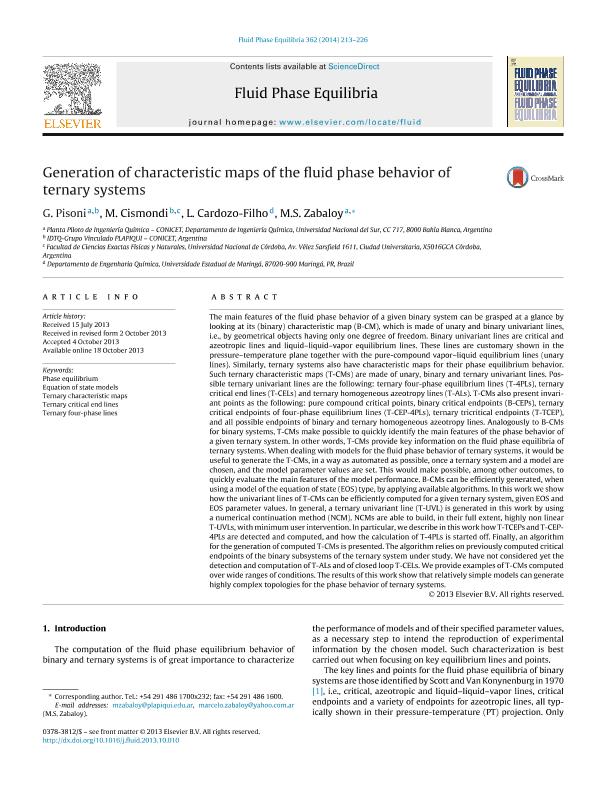Mostrar el registro sencillo del ítem
dc.contributor.author
Pisoni, Gerardo Oscar

dc.contributor.author
Cismondi Duarte, Martín

dc.contributor.author
Cardozo Filho, Lucio
dc.contributor.author
Zabaloy, Marcelo Santiago

dc.date.available
2017-04-17T18:32:23Z
dc.date.issued
2013-07
dc.identifier.citation
Pisoni, Gerardo Oscar; Cismondi Duarte, Martín; Cardozo Filho, Lucio; Zabaloy, Marcelo Santiago; Generation of characteristic maps of the fluid phase behavior of ternary systems; Elsevier Science; Fluid Phase Equilibria; 362; 7-2013; 213-226
dc.identifier.issn
0378-3812
dc.identifier.uri
http://hdl.handle.net/11336/15319
dc.description.abstract
The main features of the fluid phase behavior of a given binary system can be grasped at a glance by looking at its (binary) characteristic map (B-CM), which is made of unary and binary univariant lines, i.e., by geometrical objects having only one degree of freedom. Binary univariant lines are critical and azeotropic lines and liquid–liquid–vapor equilibrium lines. These lines are customary shown in the pressure–temperature plane together with the pure-compound vapor–liquid equilibrium lines (unary lines). Similarly, ternary systems also have characteristic maps for their phase equilibrium behavior. Such ternary characteristic maps (T-CMs) are made of unary, binary and ternary univariant lines. Possible ternary univariant lines are the following: ternary four-phase equilibrium lines (T-4PLs), ternary critical end lines (T-CELs) and ternary homogeneous azeotropy lines (T-ALs). T-CMs also present invariant points as the following: pure compound critical points, binary critical endpoints (B-CEPs), ternary critical endpoints of four-phase equilibrium lines (T-CEP-4PLs), ternary tricritical endpoints (T-TCEP), and all possible endpoints of binary and ternary homogeneous azeotropy lines. Analogously to B-CMs for binary systems, T-CMs make possible to quickly identify the main features of the phase behavior of a given ternary system. In other words, T-CMs provide key information on the fluid phase equilibria of ternary systems. When dealing with models for the fluid phase behavior of ternary systems, it would be useful to generate the T-CMs, in a way as automated as possible, once a ternary system and a model are chosen, and the model parameter values are set. This would make possible, among other outcomes, to quickly evaluate the main features of the model performance. B-CMs can be efficiently generated, when using a model of the equation of state (EOS) type, by applying available algorithms. In this work we show how the univariant lines of T-CMs can be efficiently computed for a given ternary system, given EOS and EOS parameter values. In general, a ternary univariant line (T-UVL) is generated in this work by using a numerical continuation method (NCM). NCMs are able to build, in their full extent, highly non linear T-UVLs, with minimum user intervention. In particular, we describe in this work how T-TCEPs and T-CEP-4PLs are detected and computed, and how the calculation of T-4PLs is started off. Finally, an algorithm for the generation of computed T-CMs is presented. The algorithm relies on previously computed critical endpoints of the binary subsystems of the ternary system under study. We have not considered yet the detection and computation of T-ALs and of closed loop T-CELs. We provide examples of T-CMs computed over wide ranges of conditions. The results of this work show that relatively simple models can generate highly complex topologies for the phase behavior of ternary systems.
dc.format
application/pdf
dc.language.iso
eng
dc.publisher
Elsevier Science

dc.rights
info:eu-repo/semantics/openAccess
dc.rights.uri
https://creativecommons.org/licenses/by-nc-nd/2.5/ar/
dc.subject
Phase Equilibrium
dc.subject
Equation of State Models
dc.subject
Ternary Characteristic Maps
dc.subject
Ternary Critical End Lines
dc.subject
Ternary Four-Phase Lines
dc.subject.classification
Ingeniería de Procesos Químicos

dc.subject.classification
Ingeniería Química

dc.subject.classification
INGENIERÍAS Y TECNOLOGÍAS

dc.title
Generation of characteristic maps of the fluid phase behavior of ternary systems
dc.type
info:eu-repo/semantics/article
dc.type
info:ar-repo/semantics/artículo
dc.type
info:eu-repo/semantics/publishedVersion
dc.date.updated
2017-03-06T18:08:25Z
dc.journal.volume
362
dc.journal.pagination
213-226
dc.journal.pais
Países Bajos

dc.journal.ciudad
Amsterdam
dc.description.fil
Fil: Pisoni, Gerardo Oscar. Consejo Nacional de Investigaciones Científicas y Técnicas. Centro Científico Tecnológico Bahía Blanca. Planta Piloto de Ingeniería Química (i); Argentina. Consejo Nacional de Investigaciones Cientificas y Tecnicas. Centro Cientifico Tecnológico Bahia Blanca. Planta Piloto de Ingenieria Quimica (i). Grupo Vinculado Al Plapiqui - Investigación y Desarrollo en Tecnologia Quimica; Argentina
dc.description.fil
Fil: Cismondi Duarte, Martín. Consejo Nacional de Investigaciones Cientificas y Tecnicas. Centro Cientifico Tecnológico Bahia Blanca. Planta Piloto de Ingenieria Quimica (i). Grupo Vinculado Al Plapiqui - Investigación y Desarrollo En Tecnologia Quimica; Argentina. Universidad Nacional de Córdoba; Argentina
dc.description.fil
Fil: Cardozo Filho, Lucio. Universidade Estadual de Maringá; Brasil
dc.description.fil
Fil: Zabaloy, Marcelo Santiago. Consejo Nacional de Investigaciones Científicas y Técnicas. Centro Científico Tecnológico Bahía Blanca. Planta Piloto de Ingeniería Química (i); Argentina
dc.journal.title
Fluid Phase Equilibria

dc.relation.alternativeid
info:eu-repo/semantics/altIdentifier/url/http://www.sciencedirect.com/science/article/pii/S0378381213005943
dc.relation.alternativeid
info:eu-repo/semantics/altIdentifier/doi/http://dx.doi.org/10.1016/j.fluid.2013.10.010
Archivos asociados
